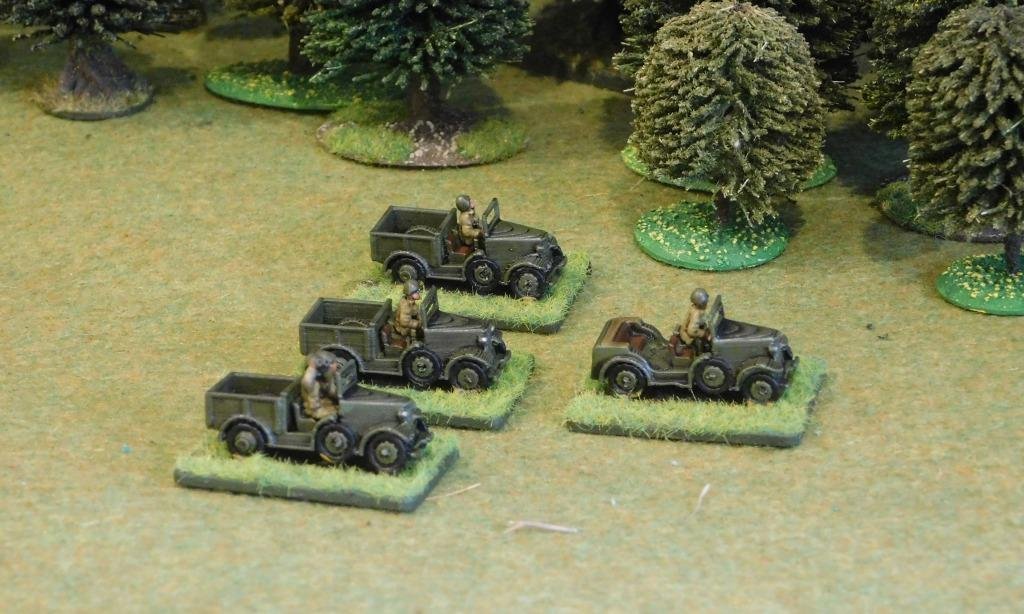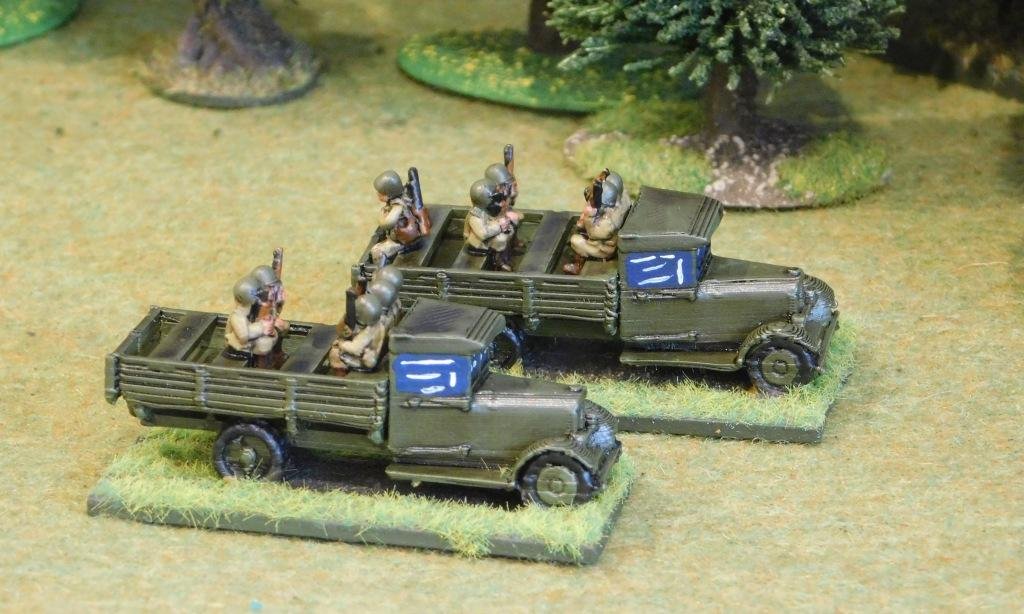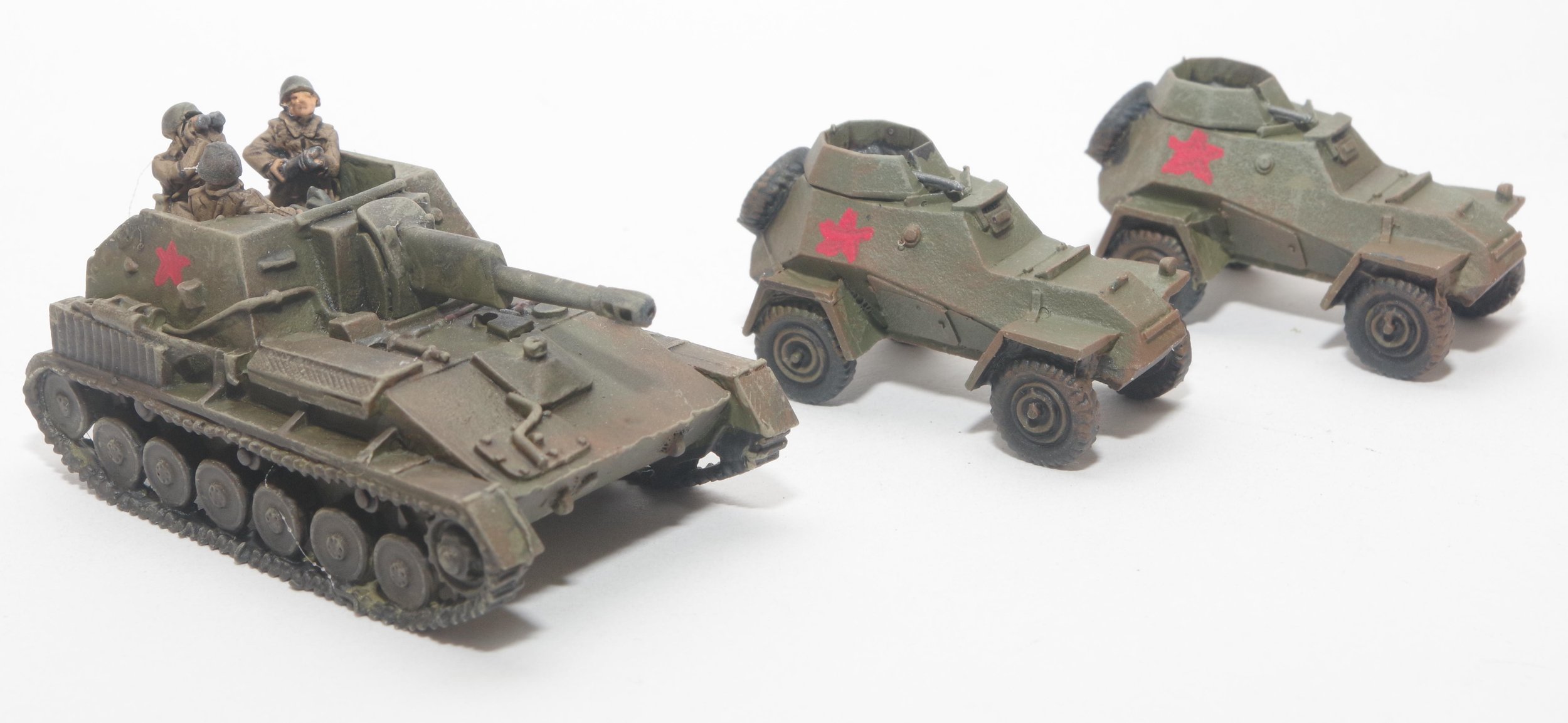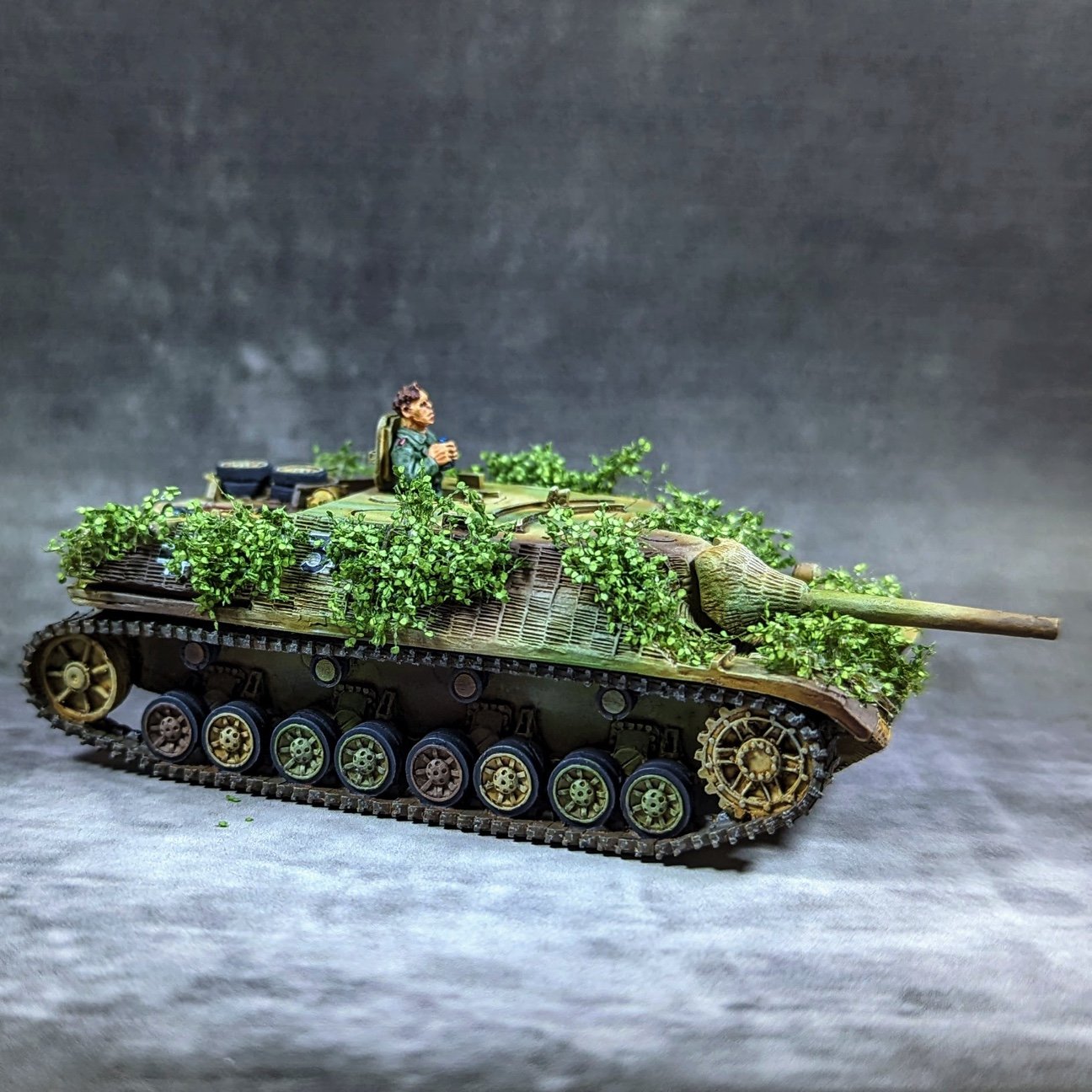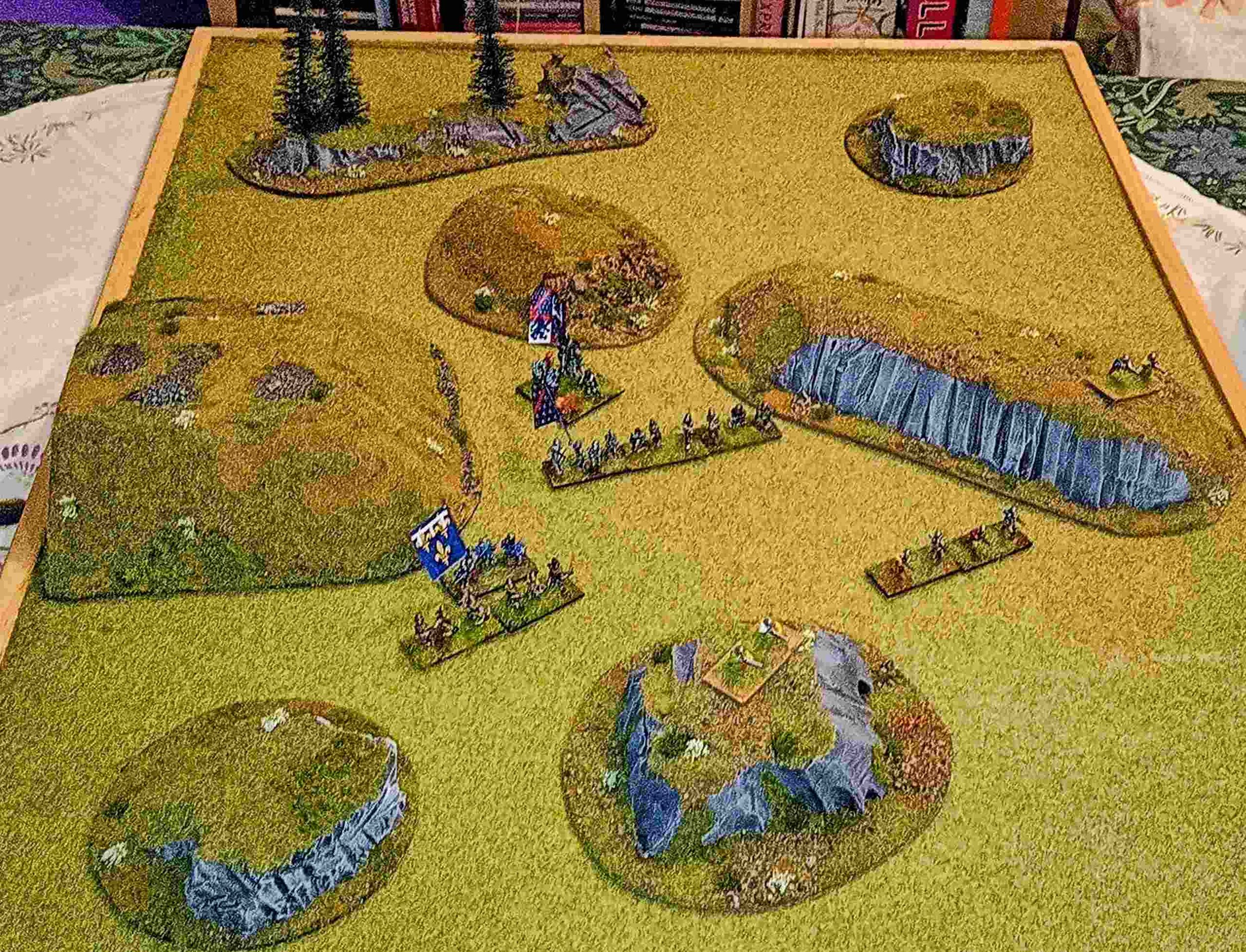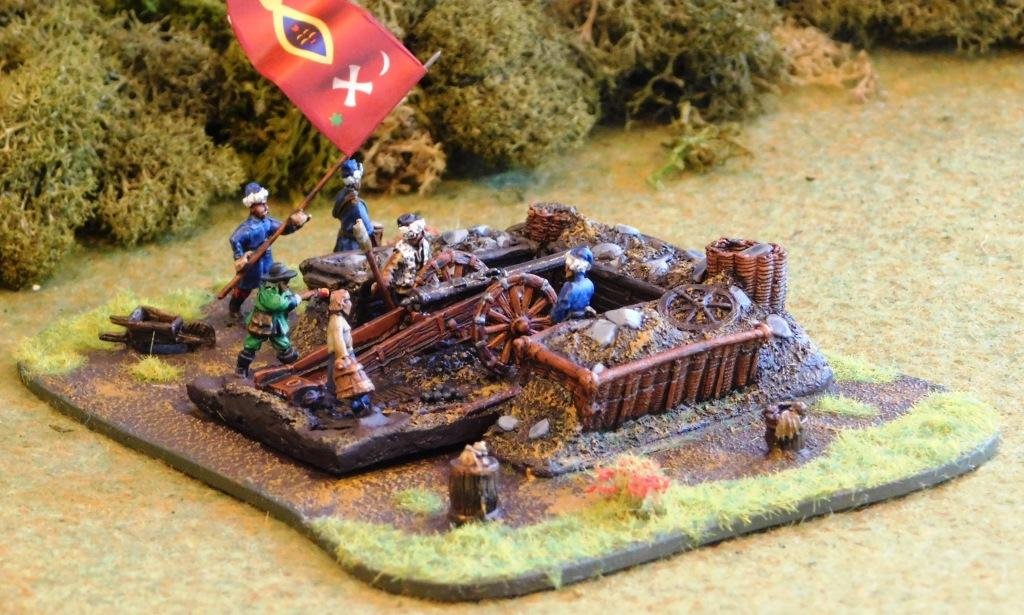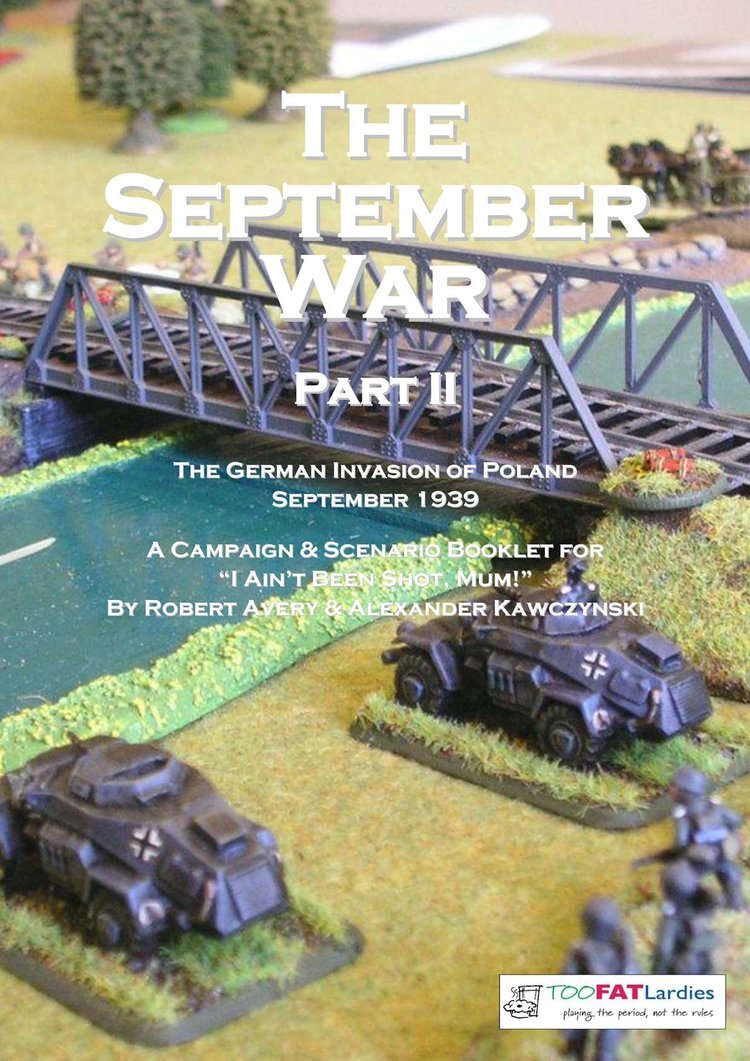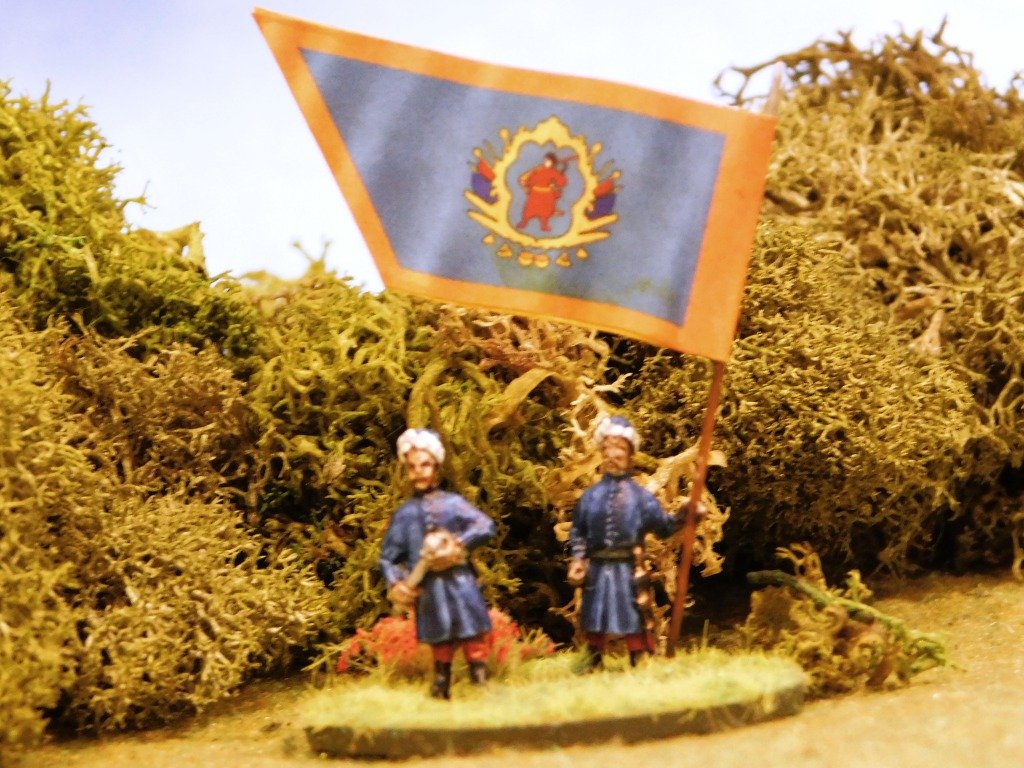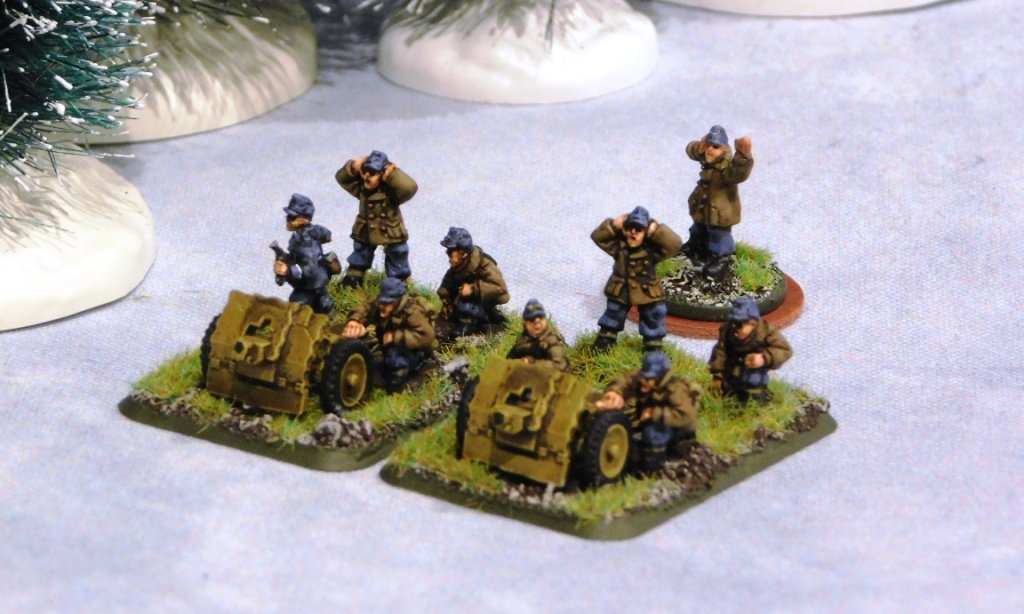IABSM AAR: St Lambert
/Dan Albrecht had a nice game of I Ain't Been Shot, Mum last week at a St. Albans, Vermont mini-con recreating the defense of St. Lambert-sur-Dives on August 20, 1944 by Canadians against the escaping 2nd Panzer Division. This AAR is taken from the IABSM Facebook Group. Click on the picture below to see all.
More from Sumer!
/One of my new year’s resolutions was to mix painting newly-bought figures with those forming the considerable lead mountain that haunts my dreams.
One significant component of the lead mountain is made up of the final units needed to complete a particular army, and one example of that has been, for quite a long time, the final unit of spearmen for my Sumerians.
Playing To The Strongest at 130 points, the Sumerians (or Akkadians or any other city state from around that time) definitely need four deep units of spearmen, and could really do with five, and maybe sometimes need six. I had five, and at 48 figures per unit, that meant I’d already painted 240 of the little devils. Hardly surprising that at that point I ran out of steam and couldn’t finish the sixth.
Those poor spearmen from the sixth battalion had been sat on my painting table, in a tray, trying to guilt me into painting them for over two years so, as I waited for the next batch of vehicles to finally finish motorising my WW2 Poles to arrive, I thought that they would be the next chunk dug out of the lead mountain.
And what a pleasure it turned out to be. I had forgotten how much fun it was to paint these chaps: all from Museum Miniatures’ excellent CAD designed Z Range. Basing them was still the same old pain (all those spears need to interlock), and I couldn’t remember how I painted the equids pulling the war wagon, but it was still a refreshing change from Poles, Cossacks or even Polish Cossacks!
And I cleared a space on the painting table too!
Cossacks Take To The Field (Briefly!)
/My first game of the year, so it was only right that the Cossacks finally take to the field with their opponents, the Polish/Lithuanians (hereafter known as the Poles/the Polish), provided by friend Bevan. So new to the table were both armies that the Poles hadn’t even been properly based yet.
The table was set up quite differently to our usual ECW terrain: no hedges and loads of irritating patches of rough or impassable ground.
We used the excellent eastern front modifications to For King & Parliament available on the Tales From A Wargames Shed blog.
View from the Polish side
The Poles arrived with a fearsome army: two units of Winged Hussars; four units of Pancerni horse; three units of Petyhorsy horse; three units of Tatar mounted bowmen; and four infantry Haiduk units.
Not properly based! Are the shades of the wargaming room to be thus polluted?
To oppose them, my brave Zaporogian Cossacks fielded four tabor war wagons; two brigades each of one unit of Registered Cossacks and two units of Moloitsy; and two Tatar warbands, one of two units of mounted bowmen, the other the same but with a unit of Tatar noble lancers as well.
Tabor in the centre, then the infantry, then the cavalry on the wings.
Here’s how the game went:
In summary, the Poles sent their cavalry forward on each wing. This proved too strong for my horse, who were mostly Tatar bowmen and reluctant Cossacks, leaving the end of my infantry/tabor line exposed.
My musket fire proved ineffective (I think it must have been raining) and although they did cause the Poles some damage, the Moloitsy infantry then began to crumble.
As the battle ended, the Poles were about to fall upon the Registered Cossacks whilst my tabor still sat in the centre watching what was going on!
Aftermath
An excellent game (despite the result!) and it was good to get back to gaming and give my latest army a baptism (of fire!).
Painting Challenge Update
/A quick update today to bring January to a close. A fine start from some people!
First up, we have Sapper’s first entries for the year. Sapper has taken part in all but the first year’s Challenge, so start’s his eighth year of participation. With an average score of 2,186 and a personal best of 2,591 (achieved last year), he is a prolific painter.
Otherwise, today we have more entries from Lloyd, Andrew, Mervyn, Carole and John. Do visit the individual galleries, but here’s a taster:
Sourcing a C4P Artillery Tractor
/The next part of motorising my 1939 Polish collection was to add some artillery tractors.
Most artillery used horse-drawn limbers, but those attached to the two motorised units used the C4P artillery tractor: a half-tracked lorry. There were two versions of this vehicle: an early model with an open cab that was almost certainly obsolete by September 1939, and a later, closed cab version:
Being Polish and being early war, none of the main-stream manufacturers do a 15mm version of the C4P, so it was back to Syborg 3D Printing to see what Simon could sort for me (see previous post Motorising a Polish Infantry Company.
Simon quickly sent through the designs that he had been able to find: the standard, accepted versions of the C4P, which split into two versions: one with benches, one with benches and boxes.
Neither looked right to me, so I consulted the “bible” for Polish military vehicles: the PIBWL military site. That site (an invaluable tool for the September War wargamer) has a whole section on the C4P, including some more pictures, one of which clearly shows the vehicle from the rear:
A few things to note here:
I also read through the (excellent) Brushes & Bayonets post about actually making your own C4P by converting other models, with the author eventually going for something like this:
Whilst I am deeply impressed by someone being able to convert like that, I’m not sure it’s quite right. As I pointed out to Simon: “I'm pretty sure that everyone who has produced a model with lower benches and/or the boxes on the back is wrong. There's deffo no pictorial evidence for your rear end on the right, just a load of pictures of models that people have made over the years. On top of that, the description from that Polish website I sent you (the WW2 Polish vehicle bible for most people) does say Underneath high benches, especially in the rear, there were some stowage boxes of unexplained purpose the key word being ‘underneath’.
“I can see why people think what they do: it looks very precarious for the crewmen my way, but it's what's in the photos: the crewmen sit, effectively, on top of storage boxes, with not very much holding them in place!!!”
I then attempted a little design work of my own, using Powerpoint to mock up what I meant:
As I’ve said before, it all looks very precarious for the crews, but then for someone who’s previously sat on a seat behind a horse-drawn limber (which looks terrifying when at the gallop) this is probably the height of safety and security!
Simon’s next attempt was almost there:
But still not quite right. This time I sketched what I wanted: emphasising the height of the box-benches and the fact they run right the way to the back of the chassis (see image, right).
A Leonardo-like work worthy of inclusion in the Louvre, I’m sure you will all agree!
Within an hour or so I had the next iteration of Simon’s designs which, I am sure this time that you will all agree, look about as right as you are going to get considering the limitations of the medium:
Although not shown, there’s a spare wheel to be stuck on, and I think the addition of some seated crew will finish it off nicely.
If anyone has any comments or further info on the subject, please don’t hold back: I can’t find a clearer photo of the actual vehicle (a photo: not a model that someone had made or a picture that someone has drawn) showing the rear bed, but I can see that my crew will sit at the right height i.e. shoulders just above the top of the cab, backsides at the same height as the truck sides.
Now I know I should end this post with a “reveal” of the completed model painted up, based and ready to rock…but they haven’t arrived yet. Give the poor man a chance to print and post them to me as we only agreed the final design yesterday!
Rest assured that when they do arrive, they go straight to the front of the painting queue, so stay tuned for more!
IABSM AAR: Home Run at Osmanville
/An excellent I Ain’t Been Shot Mum battle report for you to look at today, from Scott Miquelon’s equally excellent Little Soldier Painting Studio blog.
Scott has created a comic-book style AAR showcasing his solo game using the Home Run at Osmanville scenario from the 29 Let’s Go Large article in the TFL 2014 Christmas Special.
Click on the picture below to see all:
Motorising a Polish Infantry Company
/Quite a few of the games in the two September War scenario packs involve motorised Polish infantry, and although I had the basic troops, I didn’t have any of the vehicles necessary to represent either the 10th Motorised Cavalry Brigade or the Warsaw Armoured Motorised Brigade.
I’d thought about motorising my basic troops before, but couldn’t find anyone who did any of the FIAT 508 and FIAT 508/518 cars/jeeps/pick ups that they used, or produced an affordable FIAT 621 truck of the right type. If there’s one thing to remember when starting to collect a motorised formation, it’s the fact that they have a lot of trucks on their roster!
Then I was at Warfare 2021 at Ascot Racecourse, and got talking to Simon Ryan, who runs Syborg 3D Printing. As I was buying some tankers and bowsers (I love the wide range of “tail” vehicles that he does), I mentioned that no-one, not even him, did any of the Polish transport vehicles mentioned above. We swapped e-mail addresses, and a few days later I got a message to say that he could now print me as many of the various different Polish transport vehicles as I wanted, and sent me pictures of the CAD versions so that I could see what I would be getting.
This was too good an opportunity to miss, especially as the 508s and 508/518s were only £2 each, and the 621s only £4 each.
The Motorised Infantry Company
First up were the vehicles to carry the main infantry company (IABSM being a company-sized game). I needed one FIAT 508 staff car for the boss, and then a 508/518 jeep and two FIAT 621 trucks for each platoon.
The original designs for the 621s had open flat beds, but the pictures I had found online showed them with benches for the troops to sit on. A couple of e-mails to Simon and I had trucks with benches.
The jeeps came without drivers, but a rummage in the bits box provided them.
The Machine Gun Platoons
A motorised company has three types of MG platoon. First up are a couple of MG teams in two FIAT 508/518 jeeps; then there are four MG teams in two FIAT 621 trucks; and finally, my favourite, four MG teams each mounted taczanka-style on the back of a 508/518 pick up:
As you can see, although I just had the transport element for the integral two-gun platoon, I put seven crew members in each of the trucks: seven in the back, three in the cabin, for two five-crew teams in each truck.
Again, the passengers came from the bits box, which is why, if you look carefully, you’ll see a wide variety of helmets…although they all look just about the same in 15mm. The Uzis and Kalashnikovs that some of them are carrying are a different matter, but I’ve tried to paint them out.
The taczankas come with the stand and the gun. The standing crew member is a left-over American, the chap standing offering more ammo is a Peter Pig Soviet.
Anti-Tank Guns, Mortars and an Ambulance
Four more FIAT 508/518s were needed for the regiment-level anti-tank platoon; two more 621s provided transport for the regiment-level mortar teams; and Simon produced a rather nice hard-body version that can be used as a workshop, command vehicle or, as I have it here, an ambulance.
I used a slightly different version of the 508/518 pick ups for the AT tows: I thought they’d want to be able to jump out easily to deploy the guns quickly!
Again the crews for the mortars come from the bits box and are as cosmopolitan as before!
Motorcycle Reconnaissance Platoon
All those soft-skins can’t just motor forward willy-nilly, so I dug a pack of Battlefront Polish motorcyclists out from the depths of the lead mountain, and knocked them out to lead the way.
I only have one squad and the platoon commander, but will add a second and third squad with motorcycle combos as soon as Battlefront start producing them again.
Building and Painting
Building the models was easy: some of them needed the wheels putting on, but most came complete. The trucks needed the benched flat-beds stuck onto the frame, but that wasn’t too difficult. Getting the arms on the Battlefront motorcyclists to sit right (the drivers arms and the bike’s handlebars come as one piece so that you have to glue the rider in place then seat the arms and handlebars just so) was more difficult than assembling all of the 3D printed models combined.
To paint the models, I undercoated in Army Painter Army Green. I then block painted all the crew figures, canvas and equipment before covering everything with a GW Agrax Earthshade wash. I then washed the vehicles again to get a darker green (just the vehicles) and highlighted the crew figures. Didn’t take that long at all.
I did think at one stage that I should have painted every vehicle in the Polish three-colour camouflage, and there are artworks and pictures of models produced like that. I couldn’t, however, find any photographs showing either motorised brigade with camouflaged vehicles: most look to be the standard Polish brownish-green. My rationale was also that maintaining a fleet of vehicles in their camouflage would have been a nightmare for the workshops involved: far easier to realise that these are transport not fighting vehicles and stick to an easily-painted standard greenish-brown!
Quality
Some of the models show the graduated layers used in the printing process, but they just add a bit of depth to the look. Some of the wheels are a bit manky, and some of the edges a little “hairy” with loose strands, but nothing that doesn’t clean up quickly and easily.
Quality-wise, I would put these on a par with standard resin or metal vehicles and behind plastic vehicles…but I didn’t have to clip a whole load of parts out from a plastic frame and then glue or fit them all together. They’re also slightly cheaper (PSC £4.59 a truck, Zvezda £4.24 a truck), especially the cars/jeeps/pick ups.
Overall I’m very happy with my new transports for a Polish Motorised Infantry Company and supports. I got great service from Syborg and would highly recommend them as a supplier. I don’t know whether Simon will add these Polish models to his general listing, but I’m sure an e-mail would get you similar if you want them or, indeed, any other obscure vehicles. Highly recommended.
Painting Challenge Update
/We have some more galleries opened this week, and the second or even third submissions from some of the early birds.
Opening her score for this year, Ashley submitted some sci-fi infantry. Ashley has entered six of the last eight year’s of Challenge, with a very genteel average of 171 points per year.
Also new into bat this year is Carole, who began this year’s Challenge campaign with some WW2 Soviets…a whole platoon of them in fact. Carole has been present in each of the eight year’s that the Challenge has run, with a very strong average score of 1,553 per year.
Our third re-starter is Stumpy: a prolific re-baser of already-painted figures (an achievement in itself given how much most people detest basing). Stumpy is also an eight year veteran of the Challenge, with an average score of 2,106.
Finally we have John Emmett, who has been with the Challenge for the last three years. His first entry includes, but is not limited to, an entry from last year that I missed. Over the last three year’s John has amassed an average score of 893 points, and I recommend a visit to his galleries to see his work.
On top of the above, we have another entry from Lloyd this week (some weird looking aliens from Khurasan).
As always, do visit the individual galleries on show: plenty of inspiration to be had.
Egyptian Officer from Stumpy
Artillery for the Gebirgsjaeger
/With the 17th Century Cossacks now done, I needed something to paint whilst I decide what’s next.
Regular visitors will know that I re-photographed a lot of my collection of 15mm WW2 figures over Christmas, and re-building their galleries inspired me to fill in some of the gaps.
One such hole was some heavier artillery for my German Gebirgsjaeger mountain troops, and I remembered that somewhere in the lead mountain lurked the figures I needed. Much banging and crashing and sorting through boxes and cupboards later, I found the packet I was after: a Battlefront special order of two 105mm GebH 40 mountain howitzers (the GebH is short for Gebirgshaubitze).
The GebH 40 was the heaviest mountain howitzer ever made, but still broke down into four loads on single-axle trailers towed by kettenkrads or five pack loads carried by mules. Some 420 were made between 1942 and 1945, firing HE, AP, smoke and illumination shells.
Manpower Shortage
So I had the guns but no crews…and with Battlefront working on a reduced inventory (COVID etc) I needed to delve a bit deeper into the Lead Mountain to see what I could find to use.
First off were a few Gebirgsjaeger infantry, including two officers who would now command the gun teams: two down, eight to go.
Next I found some spare crew for the heavy mortars already in the Gebirgsjaeger collection, and although they are obviously toting mortar bombs rather than artillery shells or charges, they would do: six down, four to go. That’s where I hit the wall: no spare German artillerymen anywhere!
I did, however, find some Battlefront British artillerymen in shirt sleeves and some spare Gebirgsjaeger heads from Peter Pig’s head swap portfolio. A snip, a drill and a pin later, and I had my ten crew.
Making a Match
The next problem, of course, was how to paint them to match my existing Gebirgsjaeger: something made more difficult by the fact that I’ve been using Contrast paints almost exclusively for the last few years and the Gebs pre-date that change.
Fortunately I keep a rough record of what colours I paint things: nothing fancy, just a spreadsheet with rows labelled things like “Headgear”, “Coat”, “Trousers”, “Boots” etc. To give you an idea, the list for the Gebs was so old that it pre-dated the new GW acrylic range, so I also had to look up, for example, the fact that GW Graveyard Earth was now called GW Steel Legion Drab and, as you will see, I still didn’t get it all correct.
Some advice to all you painters out there:
Never throw any spare figures away
Always have a supply of spare heads (Peter Pig recommended)
Always write down what colours you use for your figures
The Finished Product
So here they are: two 105mm GebH 40 mountain howiters:
These look great…but I am going to have to repaint the greys because I now realise that the grey doesn’t match the Shadow Grey highlight that I used on my originals. Apparently I should have used a colour called The Fang but didn’t: I looked in the pot and thought it looked a bit blue.
So it’s back to the painting table for these guys when I get a moment: the colour will have to go on over the varnish but it’s only for a touch-up highlight so should be okay.
Here’s the infantry guns picture so you can see what I mean:
Next up: a massive bit of hole-filling for the WW2 Poles!
More 2022 Painting Challenge Galleries Opened
/Three more “regulars” back for the Painting Challenge.
First up is Steve Burt, who has participated in every year of the Challenge since we began, making this his ninth consecutive year. Steve has averaged 1,238 points per year, with a personal best of 1,716 in 2016.
Next is Andrew Helliwell, a prolific painter, who missed the first year of the Challenge but has been a steady participant ever since. Andy’s average is 2,329 per year, with his last two years both being over 3,000 points.
Finally in this set, we have Nick Cooper, who starts his second year of the Challenge. last year Nick managed 1,536 points: a very respectable first outing!
Already registered Mervyn and Lloyd also sent through a second set of entries this week. Do check out the individual galleries, but here’s a taster:
Cossack Artillery
/Fanfare please: the last of the Cossacks roll off the production line!
Well, I have one more, unopened packet of Moloitsy, but even if I did want to paint them up, there’s no room in the two Really Useful boxes that I’m using to store the Cossacks in (it’s a bit like a tabor after all!) so who knows where I’d put them. Bored of painting Cossacks now, anyway: with 231 painted since 21st October, I feel I have more than done them justice.
Just working on my tan, Alexy
First up, in the photo above, is a Light Gun base to augment stationary infantry or tabor units. Figures and gun are from By Fire & Sword, and very nice they are too, if a trifle tall.
I do like how the Contrast paint has covered the torso of our sunbather with the ramrod: that’s just one coat of Darkoath Flesh over the grey undercoat. Loving Contrast paints very much!
Next up is a standard artillery base. Not quite such a good photo, though.
You can see that I have had to import some spare Peter Pig artillerymen as the original artillery pack only contained enough gunners for two crew per piece. I’ve painted the Piggy’s contribution in the same green both on the above and the next piece: I’m calling them non-Cossack mercenaries used to train or improve effectiveness!
I do like the pose of the chap in the red trousers on the left: the one with his foot up on the barrel and staring dreamily into space. You can’t quite see it in the pic, but in his other hand, the one by his waist, he’s holding what looks like a piece of paper. I like to think it’s a letter from that special little Cossack lady expressing her love and admiration…but it’s probably a Dear John or a bill!
Finally, here’s a little gallery of the single siege artillery base I’ve painted up.
This artillery set comes with not only it’s own resin gun emplacement, but also with a separate “slide-in” base for the gun and gunners so that you can also use them on their own, behind a tabor for example. Very nifty and much appreciated.
Again, not enough crewmen though, so I’ve added a Piggy mercenary and a couple of spare command figures (the standard bearer and the drummer) to make the scenic base a bit fuller.
So that’s the Cossacks done now (or as done as any wargames project ever can be) and it’s on to the next section of the lead mountain.
No sneak previews, but I think I’ll be moving forward through time to WW2…
Free IABSM Early War Polish List Re-Vamped
/I’ve been doing some work on my collection of 15mm WW2 Poles (for the early, 1939 September War rather than the later periods) and whilst looking through the I Ain’t Been Shot Mum theatre book on the subject I noticed a somewhat embarrassing omission in one of the lists.
This has been corrected, and the v2 edition is now available to download from the Buy IABSM Theatre Supplements section of this website. Click here to go straight to the page.
Don’t worry about the “buy” bit, this theatre book remains FOC both here and on the TFL site to start players off on their IABSM journey: and where better to start than the beginning of the war (let’s not think about the Marco Polo bridge incident!).
The early war period is one of my favourite to play, and the German, and the Soviet, invasion of Poland has got a little bit of everything in it. There are also sixty (yes: sixty) scenarios available for IABSM across the two September War scenario books. You will have to pay for them, but at under a tenner for each (£8.29 to be exact) that’s only 28p per scenario.
If you’d like to read some of the After Action Reports from games that have used the scenarios, there are about twenty of them on this website, not all of them from me. Here’s a link to a good one featuring scenario #03 and you should be able to find more by navigating from there.
Re-reading a lot of them whilst writing this post, one thread that seems to run through them is how close the games are…that and how disastrous it is to put me in charge of Polish cavalry. There’s something about massed cavalry in IABSM that just screams “Charge!” to me, usually with unfortunate results for the horsemen involved!
A rare victory for the Polish line cavalry and lancers
So if your new year’s resolution is to start a new theatre or period, please do give some thought to choosing the September War: I’m certainly dusting off my figures and looking forward to working my way through the scenario books again.
First Painting Challenge Galleries Opened
/It’s that time of year when I have to build all the Painting Challenge galleries for the 2022 event, so lots of short posts rather than a bi-weekly long one.
Today we welcome back Lloyd “The Hat” Bowler for his eighth year of participation in the Challenge. Lloyd is a prolific scorer, averaging 2,887 points per year, including a personal best in 2020 of 3,709 points: an extraordinary achievement.
Today he submits some 15mm sci-fi: bugs and a couple of buildings from Khurasan’s range.
Next up is Mervyn Douglas, who has gone one better from Lloyd and been with us right from the start: this is his ninth year of taking part in the Challenge. Mervyn’s average score is 2,352 per year, setting a personal best last year with a score of 3,006.
Today Mervyn submits more 28mm Ancients: some Persians and Greeks.
You can see the full pictures of their submissions in their individual galleries: use the Navigation Bar at the top to find them. You could also look at their previous work, grouped by year, also available from the NavBar.
Cossack Command
/I’m now just working through the last few bits and pieces for my Zaporogian Cossack army for the (unofficial) eastern European version of For King & Parliament.
Here’s the latest offering, once again showcasing the beautiful banners that come ready provided by the chaps from By Fire & Sword.
Cossack Cavalry
/It’s always nice to see who’s going to be first to get an entry into the new year’s Painting Challenge and, this year, it happens to be me: the extra bank holiday day giving me the chance to both start and finish a couple of units of Cossack cavalry.
These are more from the By Fire & Sword range, and very nice they are too. It was also such a relief to paint a “regular” unit (i.e. one where the figures are all the same) after the five units of Tatars that were my final entries into last year’s Challenge.
And that, of course, is one of the reasons that I have been able to finish them so quickly: less time switching between paints and poses. That and the fact that they have very little in terms of “webbing” or equipment.
Oh, and if anyone is wondering how I got the roan colour on the unit with the purple and yellow banner, it’s using GW Contrast Fireslayer Flesh with a Cygor Brown mane and tail. I think I should have given them white socks as well, but that can easily be fixed the next time I want a roan horse.
Only a few more Cossacks to go now…
More WW2 Galleries Updated: Allied Airborne Troops, Late War Germans
/Six more galleries showcasing my collection of 15mm WW2 figures have been updated. This time it’s the turn of the Allied Airborne troops and the Late War Germans.
British
There are a few gaps in the rosters that I would like to fill, but the thought of painting any more of the camouflage Denison smocks worn by the Brits is enough to persuade me to concentrate elsewhere!
Late War Germans
Happy New Year!
/Happy New Year everyone, and may 2022 bring you lots of life, love and good gaming!
To start your New Year off with a bang, here are some of the late entries into last year’s Painting Challenge:
Review of the Year 2021
/2021 was another year largely disrupted by the continuing COVID crisis. I even caught COVID myself, in early December, and was very under the weather for a few days. Despite that, it’s actually proven to be a bumper year for me wargaming-wise. Here are a few of this year’s highlights.
Gaming
Another great year as far as actual gaming is concerned, with 47 tabletop battles fought. This is actually the highest number of games I’ve ever played in one year, beating last year’s record of 42 games by 12%.
That works out at almost one per week on average, a figure I’m pretty happy with considering I don’t belong to a club and rely on a small circle of good gaming friends to provide opponents.
The main focus was Pike & Shot: 47% or 22 games, with the play-testing for The Siege of Norchester scenario book for For King & Parliament being responsible for fifteen battles.
The moment my Commanding General and a Brigade Commander died in the same combat right at the start of playtesting the Skirmett’s Orchards scenario from “Norchester”. Not my finest hour!
After that, Ancients, with 32% or 15 games, all but one using To The Strongest, with the other being Infamy!
Finally, there were a smattering of Napoleonic (4), 19th Century (3) and WW2 (3) battles.
Interestingly, just about half of them (twenty-three to be exact) were fought remotely using Zoom in the first half of the year when we were all still in lockdown. They were nearly all grid-based games (either TTS or FK&P) as they particularly lend themselves to gaming over the ‘Net.
The gaming table set up for an online session: Marian Romans versus Gauls IIRC.
Not sure that I have a favourite game, but very pleasing was the opportunity to get some of my 19th Century figures back onto the tabletop after over twenty years: see the section on Re-Basing, below, for more.
Painting - Overview
Not a particularly good score in this year’s Painting Challenge but I think this is mostly because I’ve produced very few terrain items compared to previous years. I’ve also been gaming more and, as always, it’s a matter of balancing what free time I have between the painting and the playing. This year felt about right.
Painting - New Armies
Three new armies were started in 2021, all in 15mm.
A long term project, I now have three battalions of 15mm early period French Napoleonic infantry completed. I’m not pushing these particularly: they are a side project for whenever I need a break from painting hordes of something else. The main problem, as ever, is that I am yet to find a set of rules that I like sufficiently enough to inspire me to move Boney’s boys onto the main production line: something else to be rectified in the new year.
AB Figures painted mostly with Contrast paints. Those cockades will be the death of me!
Zaporogian Cossack Commanding General
The other two armies are both for the unofficial Eastern European version of For King & Parliament from the Tales From A Wargaming Shed blog, and are connected in as much as I have built a Zaporogian Cossack army with Tatar allies. I would say that this army (or armies, dependent on how you look at it) are just about finished now, or as finished as any wargaming project can ever be!
Amusingly, when I started the army as an opponent for friend Bevan’s Poles (currently on his painting table) I imagined I would be painting hordes of light cavalry, but it turns out that these Cossacks were of the infantry variety not the mounted sort, hence the Tatar allies to provide decent horse. These are the Cossacks that fought on foot from behind war wagons.
I’m sure you’re supposed to do your research before you buy your figures but, in this case, it turned out to be quite fun to do it the other way round: I now know much more than I used to about the Zaps, including the fact that they mostly fought on foot!
Painting - Re-Basing
My 19th Century armies have spent a long time languishing in their boxes, so it was a real pleasure to find a set of rules (Neil Thomas’ Wargaming 19thC Europe 1815-1878) that inspired me enough to get some of them out and have a play.
A couple of games later and I realised that part of what had been preventing me from using them had been the weird basing system I had used when I built the armies some time ago: a consequence of using home-brewed rules based on a cross between Johnny Reb and Trevor Halsall’s 19th Century set.
The Re-Based Prussians
With more 19thC games on the horizon, there was nothing for it but to bite the bullet and re-base…so I did, starting with the Austrians, Prussians and French. Lots of wars between those three: Franco-Austrian (1859), Austro-Prussian (1866) and Franco-Prussian (1870).
In all I re-based over 800 infantry, almost 200 horse and about 20 guns/wagons: a horrible experience that I wouldn’t wish on anyone. The fear of breaking the models as you take them off their old bases (there were a few casualties) combined with the monotony of flocking making the whole thing very tedious and stressful.
But at least the figures look good now, and It has been a real pleasure to get them on the tabletop again after 25 years! Just goes to show that my adage about never selling any figures ever still holds true!
Back on the tabletop after more than twenty years!
Publishing
With last year’s Marlowe to Maidenhythe scenario pack for For King & Parliament selling well, I managed to follow it up with another: The Siege of Norchester. This now gives FK&P players 24 different games to play, each of which can be played on both sides and with or without the set deployments given. If my maths is correct, that gives 96 possible combinations before you have to play exactly the same game more than once. As the Lone Ranger said “my work here is done” and I need to find a new project to work on.
Less pleasing was the fact that I made little progress on my next IABSM theatre supplement: the Allied forces in the Far East. I did spend a lot of time researching the basic British and Commonwealth lists, which are finished, and have worked my way through specific lists for most of Malaya, but the sheer volume of what I need to do has slightly overwhelmed me. I shall re-approach the subject in the new year and see if I can get any further.
Looking Forward to 2022
So what do I want to achieve in 2022, what are my new year resolutions?
First up I’d like to hit 52 games in a single year i.e. an average of one a week. Might be tough, especially if lockdown lasts a long time, but it’s a good target to go for.
Secondly, I’d like to finish the IABSM Blitzkrieg Allies in the Far East theatre book for IABSM, and produce some kind of scenario or campaign pack for To The Strongest.
Thirdly? Well thirdly I’d just like to keep on painting and adding to my collection. I’d like to get an opponent for the Cossacks done, add a Crusader army to my TTS roster, and keep on filling in the gaps in my other forces.
Have fun tonight (COVID allowing!) and I;ll see you all next year!





























